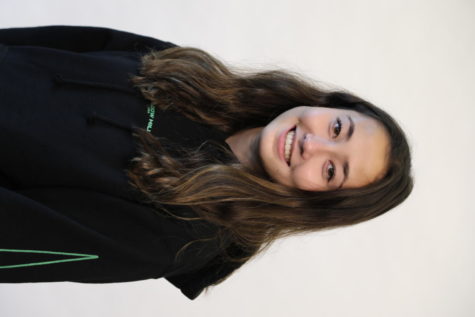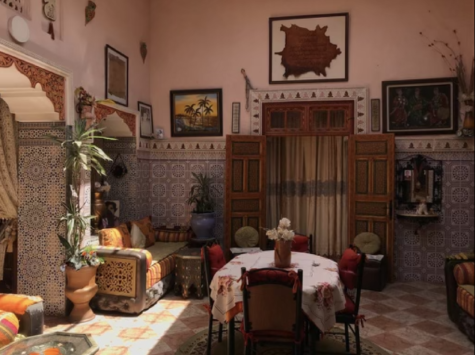
Number of years in The Coat of Arms: 3
Favorite aspect of journalism: writing about topics I'm passionate about, like music.
Interests outside of school: working at Tin Pot Creamery, baking, and dancing.
Class of 2023
January 6, 2023
During her stay in Morocco, Hratko went camping for one night in the Sahara Desert, where she had the opportunity to ride a camel for the first time. “They’re not like horses,” she said. “[They] were really, really tall.” Photo courtesy of Jane Hratko
On June 20, 2022, senior Jane Hratko boarded her first ever international flight, preparing to spend the next six weeks studying Arabic in Rabat, Morocco. In addition to this being her first time venturing outside of the United States, this trip would also mark Hratko’s first time flying alone. However, while Hratko entered her summer unsure of what to expect, it ultimately entailed a new heightened understanding of Arabic, new people to connect with and, most importantly, a new culture to explore.
Prior to studying Arabic, Hratko studied Spanish as her first foreign language. In fact, Hratko credits her Spanish studies for sparking her interest in Arabic. “I took a Spanish course sophomore year that largely focused on medieval history,” she said. “There’s a lot of intersection between Arabic and medieval Spanish histories.”
Hratko also became interested in Arabic because it was an opportunity to learn about a more foreign culture. “Spanish is very familiar. We live in an area with a lot of Spanish speakers,” she said. “Arabic was just more different to me.” After Hratko’s sophomore year, she began taking Modern Standard Arabic classes through the Global Online Academy. At the same time, she submitted an application to the National Security Language Initiative for Youth, a program that sends students to study MSA in three possible locations: Jordan, Oman or Morocco. NSLI-Y is also offered by the U.S. Department of State, meaning all accepted students have a full-ride, so Hratko’s trip was paid for by U.S. taxpayers.
When Hratko was selected for the Morocco destination, she was assigned a host family, as well as another American student to be her roommate. “The situation with host families is complicated, because you never know who you’re gonna get,” Hratko said. “I got the most precious host family. They always said, ‘I think of you as my own daughter.’” Hratko’s name also does not translate well into Arabic phonetically, so her host mother opted to call her “John” instead. “As a term of endearment, she would add the possessive […] ‘y,’ like ‘Johnny,’” Hratko said. “My whole cohort started calling me John or Johnny, and I thought that was really wholesome, with the meaning behind it.”

Hratko’s host mother did not speak English, which at times made communication difficult. “I would talk to her in MSA, and she would respond in colloquial Arabic, which is very different,” she said. “It’s a mix of French and the indigenous language in Morocco.” Hratko faced similar language barriers with other people throughout her trip, too. In souks, or bazaars, shopkeepers often assumed that Hratko knew how to speak French, rather than MSA. “There was a lot of French going on, and I didn’t speak French,” Hratko said. “I would always be like, ‘Arabic!’ And they’d be like, ‘French!’”
According to Hratko, a normal day in her life while in Morocco consisted of four to six hours of MSA classes. Hratko and her roommate commuted by taxi to a local Arabic school for international students called Qalam wa Lawh. “Some days, I stayed at school for an extra hour of tutoring because it was free,” Hratko said. “Other days, if I ended up going straight home, I would be with my [host] sister because she didn’t really have anything to do over the summer.”
Hratko also noticed that her host family’s daily routine was quite different from that of her own back in the United States. “I would come home from school and it would be like 5 p.m., and [my host family] would be having lunch,” Hratko said. “Moroccan mealtime is different [from ours], so my family ate dinner around 11 [p.m.] or 12 [a.m.].” According to Hratko, this messed with her sleep schedule a lot, especially since she had to wake up early for school at about 6:30 a.m. everyday. Additionally interfering with Hratko’s sleep, she and her host family lived right next to a mosque, and could hear the Islamic call to prayer ringing about five times a day — including at 5 a.m.
According to Hratko, the location of her host family’s home showcased some of the most beautiful sites she has ever seen. “Morocco is just an incredibly colorful place, and that’s part of what I love so much about other cultures, just that kind of liveliness and togetherness and joy,” she said. “My [host family’s] house was in front of this bright blue gate, and the walkway up to our house was painted like rainbow tile. Now, we turn left onto my street — I called it vegetable lane because that’s where they kept all the produce — and all of the overhangs over the stalls and souks were mint green. The whole place was just a burst of color.”
Hratko’s trip was not limited to Morocco’s capital, either. On weekends, she often traveled outside of Rabat to visit other popular cities and attractions. One of Hratko’s favorite trips was to Merzouga, a small town located in the Sahara Desert, where she was able to ride a camel all by herself. “Camels are really scary,” she said. “I was trying to take videos and document being on [the] camel, but I felt like I was going to fall off.”
Hratko also made good use of her Spanish while in the northern areas of Morocco: Tangier and Chefchaouen. “Those are towns with a high Spanish speaking population because there’s this really complicated legacy of colonialism in Morocco, and […] I got to speak Spanish to some of the shopkeepers,” she said. In addition to traveling to the north, Hratko also spent time in Marrakech, which she believes to be one of the best places in Morocco for a tourist to see.
As a current senior, Hratko is continuing to study Arabic online at the Global Online Academy, and considers it one of her most difficult courses. While Hratko hopes to pursue a degree in Middle Eastern Studies, she is also eager to take a gap year in Jordan first. This would serve as an opportunity to expand her Arabic studies to colloquial Arabic, in addition to MSA.

Number of years in The Coat of Arms: 3
Favorite aspect of journalism: writing about topics I'm passionate about, like music.
Interests outside of school: working at Tin Pot Creamery, baking, and dancing.
Class of 2023